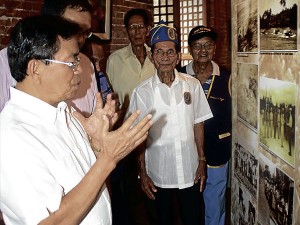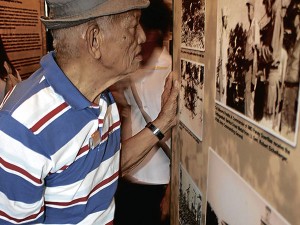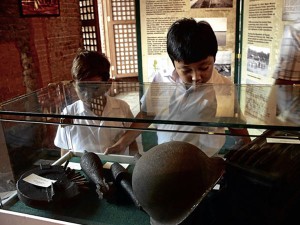Bank teaches legacy of war vets

THE CORPORATE social responsibility of Philippine Veterans Bank is unique: It mounts an exhibit of vintage World War II photographs to honor Filipino soldiers and teach young people about freedom and love of country. Photo by Tonette Orejas, Inquirer Central Luzon
CITY OF SAN FERNANDO—The Philippine Veterans Bank performs its corporate social responsibility in unique and specific ways.
For six years now, it has been touring the exhibit called “War of our Fathers.” It also sets aside 20 percent of its net income to the board of trustees for the veterans of World War II.
This group, together with the heirs, manages the funds through which the veterans get free medical services and medicines in partner-hospitals.
The funds represent the P80 to P120 shares of 400,000 veterans who are also bank stockholders.
“The pressure for us to generate net income each year is not just a business objective but also a social mission,” says Miguel Villa-Real, vice president of PVB corporate communications.
Among the country’s commercial banks, PVB moved up from the 32nd slot in 2004 to 18th place last year. Its assets grew from P17 billion in 2004 to P56 billion in 2011.

THE CORPORATE social responsibility of Philippine Veterans Bank is unique: It mounts an exhibit of vintage World War II photographs to honor Filipino soldiers and teach young people about freedom and love of country. Photo by Tonette Orejas, Inquirer Central Luzon
“If our net income declines, that means less medicine and medical services to our WWII heroes who are our stockholders, their widows and children, especially the indigent ones,” Villa-Real says.
The Multi-Sectoral Governance Council of San Fernando brought to this city the mobile exhibit, which opened on Aug. 31 and will run until Sept. 11 at the newly restored Philippine National Railways station downtown. The exhibit’s next stop is Paniqui, Tarlac.
The San Fernando leg of the tour drew war veterans Ruben Sta. Ana and Vivencio Tizon.
They asked their relatives to take them to the station that is historic for two reasons: via train, the national hero, Dr. Jose Rizal, reached Pampanga and recruited leaders for reforms here; and Japanese troops herded American and Filipino soldiers on closed train vans in San Fernando for the final destination of the Death March in Camp O’Donnel in Capas, Tarlac.
Viewing vintage photographs of World War II in the Philippines between 1941 and 1945, the 92-year-old Sta. Ana says: “These are remembrances.”

THE CORPORATE social responsibility of Philippine Veterans Bank is unique: It mounts an exhibit of vintage World War II photographs to honor Filipino soldiers and teach young people about freedom and love of country. Photo by Tonette Orejas, Inquirer Central Luzon
Tizon, 79, says he felt proud of the assembly of images and memorabilia. “Freedom was fought and won by us Filipinos. It did not come easily. A lot of lives were put on the line,” he says.
In no unhurried ways, Sta. Ana, Tizon and 20 fellow veterans in Pampanga beheld the photos with mixed feelings. One quietly wept for comrades who died in battle or during the Death March.
“The thought of defeat was also painful,” says Tizon.
The exhibit, complete with video documentaries, is for old soldiers as it is for the younger generations.
Jussel Barroma, 10, says: “The exhibit was nice. I learned many things. Filipinos were very courageous during the war.”
